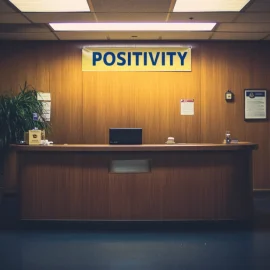
Do you often make snap judgments about people that leave you feeling disconnected and alone? In our swipe-left culture, we’ve become experts at writing people off at the first sign of imperfection, but psychologist Ali Fenwick argues this approach is robbing us of meaningful connections.
Fenwick’s “Red Flags, Green Flags” framework offers a refreshing alternative to our tendency toward instant dismissal. Rather than viewing red flags as automatic deal-breakers, his RED system encourages deeper examination of both our reactions and others’ behaviors. Meanwhile, his GREEN framework helps identify the genuine qualities that make relationships worth nurturing. Keep reading for an overview of the book and Fenwick’s system.
Overview of Red Flags, Green Flags
Dating apps and the fast pace of modern society have made us much too eager to write people off at the first sign of imperfection. In Red Flags, Green Flags (2024), psychologist Ali Fenwick argues that these snap judgments about people are often wrong and are robbing us of opportunities for deep, meaningful connections. To address this problem, he presents a framework that transforms warning signs (“red flags”) into opportunities for reflection, and positive traits (“green flags”) into catalysts for stronger relationships. This guide will help you cultivate the self-awareness and communication skills needed to build authentic, enduring connections—both personal and professional—in an increasingly disconnected world.
Fenwick brings over two decades of study and practical experience with human behavior to this exploration of modern relationships. As Professor of Organizational Behaviour and Innovation at HULT International Business School in Dubai, he’s spent the past decade teaching current and future executives around the world how to apply psychological principles to both their jobs and their personal lives. Fenwick is also the founder and CEO of the Netherlands-based consulting firm LEAD TCM&L—The Center for Applied Behavioral Science & Technology.
We’ll start this guide by explaining what Fenwick means by red and green flags, and how his system can help you deal with unhealthy relationships and strengthen healthy ones. We’ll then examine why self-awareness and personal growth are central to your ability to build healthy relationships, and how you can cultivate those skills. We’ll conclude by discussing some specific warning signs and positive traits in certain types of relationships: those you have with family and friends, your professional relationships, and your romantic relationships.
The RED Flag, GREEN Flag System
Fenwick starts by introducing his “flag” system and explaining why it helps you navigate your relationships. Note that this system isn’t only meant for romantic partners: It’s equally valid for your relationships with friends, colleagues, family members, and so on.
In this section, we’ll explain Fenwick’s RED acronym and how to apply it in your daily life. We’ll then do the same for GREEN.
RED: How to Spot and Deal With Toxic Behaviors
Fenwick created the acronym RED (Reflect, Engage, Decide) to describe a deliberate process you should use when you encounter what appears to be a troubling sign—a “red flag”—in someone else’s behavior. This framework encourages you to pause your automatic reactions and deeply examine what’s happening: why the person’s behavior bothers you, whether the issue really stems from them or if you’re projecting your past experiences, and how to handle the situation constructively.
R: Reflect on Your Emotions
The first step of Fenwick’s process is to reflect. It’s hard to understand people’s actions (including your own) while you’re upset. Therefore, it’s crucial to get away from the situation, calm down, and think deeply about what happened.
Specifically, consider whether the person’s behavior warranted such a strong reaction—and, if not, where your response came from. You’ll often find that you were really reacting to some unresolved issue or trauma from your past that the other person’s actions dredged up. For example, someone raised in an abusive household will often have strongly negative reactions to people raising their voices, even if those people are excited rather than angry.
E: Engage With the Other Person
Once you understand why you had such a strong response to what happened, you’re ready for the next step of Fenwick’s process: Engage with the other person and tell them what you discovered. If your reaction stemmed from your past experiences, be sure to acknowledge that. Conversely, if their actions really were disrespectful, callous, or otherwise hurtful, it’s important to let them know.
When you give this feedback, Fenwick advises you to observe whether the person handles it with genuine respect and empathy. If they’re receptive to what you’re saying—even if they don’t fully understand or agree with it—the two of you can start a conversation about how to avoid or deal with similar problems in the future. On the other hand, if they’re not willing to listen, they’ll probably be equally unwilling to change their behavior.
D: Decide What to Do Next
The final part of the RED flag method is to decide what to do. Fenwick strongly emphasizes that only you can judge what’s right for your specific situation, but he does offer some guidelines.
If the other person takes what you said to heart and tries to avoid upsetting you in the future, it’s likely that you’ll decide you don’t need to do anything else. However, if the hurtful behavior continues, the next step is to set boundaries: Make it clear that you won’t accept how they’re treating you, and explain how you’ll respond the next time it happens. For instance, if you’ve told a coworker that you need to be left alone so you can concentrate, but they don’t respect your wishes and keep interrupting your work, your response might be to raise the issue with your supervisor.
Fenwick adds that, ultimately, you might have to decide whether a particular relationship is worth keeping. Again, only you can make this decision: You’ll have to consider how important the relationship is to you, how much the person’s actions harm your well-being, and what you’d lose by ending the relationship.
For example, if your boss keeps harassing you to work weekends when you’ve already said you can’t, perhaps it’s time to look for a new job. Similarly, if you’ve told a family member that their rude “jokes” are hurtful and they keep making such jokes, you’ll have to decide whether to keep that person in your life or cut off contact with them.
GREEN: How to Recognize a Healthy Relationship
The other flag in Fenwick’s system is GREEN. Whereas RED was a process to go through when you encounter troubling or upsetting behaviors, GREEN is a mnemonic for the attributes of a healthy relationship: Genuine, Respectful, Empathetic, Elevating, and Nurturing. Note that each of these should be reciprocal, meaning that in a healthy relationship, you and the other person both demonstrate these positive behaviors.
The first aspect, genuine, means that the person’s actions come from who they truly are, not from trying to impress you or get something from you. You can spot genuine behavior by watching to see if they act the same way in different situations—for instance, are they as kind to cashiers as they are to you?
Someone who’s respectful values you for who you are (not just for what you can do for them), heeds your boundaries, and doesn’t try to change you into someone else. Respect also means they treat you well even during fights and other stressful situations, never resorting to abuse or manipulation.
An empathetic person understands your feelings and responds with care and thoughtfulness. For example, they really listen to you when you’re upset and understand whether you’re looking for a solution or if you just need to vent—and if they aren’t sure, they ask. Fenwick says empathy may be the single most important element of a healthy relationship, because it’s impossible to treat each other well if you don’t understand one another.
Elevating means a healthy relationship where people uplift and empower each other. In other words, a relationship that consistently makes you feel better, helps you overcome obstacles and reach your goals, or makes you want to improve yourself is one that’s worth keeping.
Finally, Fenwick points out that a good relationship nurtures all these positive qualities. This means the other person acknowledges and appreciates what you do for them, and you do the same. Nurturing the relationship in this way continually reinforces the good aspects of it, and makes problems easier to recognize and deal with as they arise.
Relationship Skills Require Self-Awareness
We’ve explained the basics of Fenwick’s RED and GREEN system. However, Fenwick says that your ability to effectively use this system depends on your level of self-awareness and emotional well-being. In this section, we’ll discuss why that is and go over some of the specific skills Fenwick urges you to cultivate.
Improve Yourself to Improve Your Relationships
According to Fenwick, your ability to recognize red and green flags in others is directly related to your level of self-awareness and personal growth. Developing emotional intelligence and self-reflection skills will help you distinguish between when others’ behavior is legitimately concerning, and when you’re unfairly projecting your past experiences onto them. Furthermore, if you’re committed to self-improvement, self-control, and healthy communication, you’ll naturally attract others who share those values—plus, you’ll be able to recognize and deal with the ones who don’t.
On the other hand, if you blame others for all of your relationship problems and refuse to take responsibility for your own role in relationship dynamics, you’ll keep having the same kinds of problems over and over again. Fenwick says that if you haven’t addressed your own trauma, insecurities, or self-destructive patterns, you’re likely to attract toxic partners who want to take advantage of those vulnerabilities. For example, someone might exploit their partner’s fear of abandonment by threatening to leave whenever they don’t get their way.
Without self-awareness, you’re also likely to misinterpret normal behaviors as red flags, because you’ll be hyperaware of anything that reminds you of your past traumas. For example, someone standing too close to you might make you think they’re trying to intimidate you, when perhaps they just didn’t realize you were there. The opposite is also true: If you don’t have a healthy sense of self-awareness, you might not recognize when someone is treating you badly or taking advantage of you.
Self-Improvement Begins With Self-Reflection
Fenwick says personal growth starts with self-reflection. After all, you can’t work on improving yourself until you have a clear idea of what to improve and how to do it.
One way to practice self-reflection is to ponder difficult questions that force you to think deeply about yourself and your behavior. When you find yourself repeatedly drawn to problematic situations or people, ask yourself things like: “Do I find this dysfunction exciting or familiar?” or “Do I see this person’s red flags in myself, and is that why we were drawn to each other?”
When answering such questions, don’t just settle for the first answer that comes to mind. For instance, say you have a friend who often “jokingly” insults you—think about whether you’re really having lighthearted fun together, or if you’re just enduring the insults in order to keep the peace.
Fenwick also urges you to explore your personal deal-breakers in relationships and friendships. Consider both what behaviors you find unacceptable and why you have such strong feelings about them. This kind of honest self-examination helps you understand whether your reactions are reasonable, or if they’re the result of unresolved issues from your past.
Apply RED and GREEN to Different Situations
Now that you’re familiar with Fenwick’s RED and GREEN system and how building self-awareness will let you use it more effectively, let’s explore how you can apply this system in three of the most important relationship types: those with friends and family, with coworkers, and with romantic partners.
Relationship Type #1: Family and Friends
The first relationships Fenwick discusses are those with your family and close friends. We’ll start by explaining some common warning signs that such a relationship might be toxic, then move on to describing what a healthy relationship with a family member or friend looks like.
Red Flags From Family and Friends
First of all, a major warning sign of an unhealthy relationship is when a family member or friend doesn’t respect your autonomy. Fenwick says such people will try to interfere in your decisions and tell you what to do, even after you ask them to give you space. This includes parents who refuse to treat you like a competent adult, and anyone who tries to coerce or trick you into doing what they think you should do instead of letting you reach your own conclusions.
Another common tactic in unhealthy relationships is emotional manipulation: the person uses guilt trips, emotional blackmail, or phrases like “you owe me” to control your behavior. Such actions turn your natural, healthy feelings of love and gratitude against you.
Finally, Fenwick says it should raise alarms when people engage in malicious gossip, spread hurtful rumors, or put people down rather than addressing problems with them directly. Beware of this kind of behavior even if it doesn’t seem to be directed at you—if your family or friends gossip about people who aren’t around, they probably talk about you behind your back.
Green Flags From Family and Friends
Along with his warning signs to watch out for in your relationships with family and friends, Fenwick provides some key signals that you have a healthy relationship based on his GREEN framework.
For one thing, if you have a strong and healthy relationship with someone, you feel secure in having honest, genuine conversations. The two of you can discuss difficult topics frankly, because you trust each other not to be manipulative or (intentionally) hurtful, even during vulnerable moments. As a result, you can work together to resolve conflicts instead of fighting with one another.
Fenwick also puts a great deal of emphasis on the idea that healthy relationships involve a natural process of give-and-take where everyone contributes and receives support. This ties into the elevating aspect of a good relationship: Each of you helps the other and accepts their help in return.
The balance of how much each person gives and takes will shift from day to day, but it should be fundamentally fair over time. For example, if your friend is sick, you might bring them food, keep them company, or help out with household chores. Ideally, they’ll do the same for you on days when you’re not feeling well.
Relationship Type #2: Professional Relationships
The next relationships that Fenwick discusses are professional relationships. These can include colleagues, supervisors, or anyone else you regularly interact with at work. The hierarchy of a workplace often adds an extra layer of complexity to relationships, especially with those who have authority over you.
As before, we’ll start by discussing some common warning signs of a toxic workplace, then move on to describing how a healthy workplace relationship should be.
Red Flags in the Workplace
Fenwick says that toxic relationships in the workplace can be just as harmful to your well-being as toxic relationships with your friends and family. To help you recognize and navigate these issues, he provides some examples of common hurtful behaviors that you might come across.
First of all, many toxic workplaces don’t respect their employees’ boundaries. This is essentially the same issue as with family and friends who don’t respect your boundaries, but it manifests differently in a professional setting. Common red flags include managers who demand constant availability with no regard for your work-life balance, and bosses who use manipulative language like “we’re a family here” to demand excessive loyalty and self-sacrifice. These flags signal that your workplace expects you to put the company’s needs above your own.
Next, Fenwick says to watch out for jobs that manipulate their employees rather than treating them honestly and fairly. For example, one common practice is to frequently change goals and how they’re tracked. This is often a way for bosses to avoid paying out bonuses or to punish employees they don’t like, regardless of their actual job performance.
Also, try to recognize when a company doesn’t keep its promises, especially when it comes to job advancement. For instance, your supervisor or manager might constantly promise that you’ll get promoted soon, then always have some excuse for why it didn’t happen during the latest round of promotions.
Finally, the author says micromanagers—bosses who get overly involved in your work and insist you do everything their way—are a common sign of a toxic work environment. Micromanagement isn’t just annoying, it’s a sign that your supervisor doesn’t trust you to work independently. Such people prioritize their own need for control over their workers’ autonomy and well-being, which creates an environment where people can’t thrive or grow to their full potential.
Green Flags in the Workplace
After discussing some common red flags that show up in professional settings, Fenwick shows how you might apply his GREEN framework to the workplace.
To start, Fenwick says that healthy workplace relationships begin with respect for employees and colleagues. This green flag is, in essence, the opposite of the red flags we discussed before: Your manager should honor your need for work-life balance, rather than demanding that you always be reachable to discuss problems or cover shifts. Similarly, your supervisor should respect you enough to trust that you can handle your own work and refrain from micromanaging you.
As a rule of thumb, a respectful work environment is one where leadership focuses on outcomes rather than processes. In other words, as long as you’re meeting your goals, there’s no reason to demand that you put in extra work or try to control how you work.
Building on this foundation of mutual respect, the author says healthy workplace relationships flourish through transparency and reliability—which really means that people are genuine with each other. For example, company leadership should set goals for you that are clear and challenging, but achievable. There should also be clear documentation of any conversations and agreements between you and your supervisor. This ensures that everyone’s clear about what they expect from each other, so your goals won’t suddenly change and your boss can’t go back on their promises.
Fenwick concludes that this workplace culture of authentic care and follow-through naturally elevates employee performance by developing their skills while protecting their well-being from burnout, discouragement, and undue stress. High-performing employees, in turn, elevate the company’s reputation and profits.
Relationship Type #3: Romantic Relationships
The final type of relationship Fenwick covers is the romantic relationship. While strong feelings and hopes for the future can complicate these relationships, the warning signs and green flags—as well as the author’s system for handling them—remain essentially the same.
Red Flags From Romantic Partners
Healthy romantic relationships start with a foundation of mutual respect, trust, and connection. Therefore, Fenwick’s warning signs all relate to behaviors that undermine those basic needs.
The first thing the author warns you to be careful of is a romantic partner who tries to manipulate or control you. If you feel the need to carefully watch everything you say or do, it’s likely that you’re in a relationship with an overly controlling person.
There are numerous methods a controlling partner might use to keep you obedient. These may be overt behaviors like intimidation and abuse, but also include manipulative tactics such as extreme jealousy and “love bombing,” where they shower you with excessive affection and then withdraw it. Love bombing makes you want to go to great lengths to please your partner in the hopes that they’ll start showing you that heightened level of love and passion again.
Fenwick says the second major warning sign of a toxic partner is that they betray your trust. This might simply mean they habitually lie to you, but there are any number of other ways for people to destroy the mutual trust that a healthy relationship needs. If your partner’s behavior leads you to doubt whether they’re generally honest and trustworthy, it may be time to reconsider your relationship.
A partner who cheats on you, or plays dating games like suddenly cutting off contact (ghosting) or giving you just enough attention to keep you interested (breadcrumbing) is showing that they put their own wants above basic respect and honesty. Such people might also refuse to clearly define your relationship in order to keep you confused and hanging on, or they use guilt trips and emotional tricks to avoid taking responsibility when they make mistakes.
Finally, Fenwick says you should beware of people who struggle with genuine emotional connection. Such people will get into relationships just to meet their own needs, rather than because they actually love and value their romantic partners.
There are various reasons why people can’t form real connections. For example, someone might be emotionally shut down from past trauma, they might value drama more than love, or they might get into relationships for unhealthy reasons like the fear of being alone. Regardless of the reasons for their behavior, if you feel like you’re being taken advantage of, it’s time to apply Fenwick’s RED method.
Green Flags From Romantic Partners
Fenwick’s warning signs about romantic partners have to do with a lack of respect, trust, and connection, so green flags in a romantic relationship are the opposite: behaviors that support and strengthen those fundamental needs. These include:
- Open, honest communication: You both feel safe discussing difficult topics such as insecurities, needs, boundaries, and past conflicts. You trust one another to handle difficult subjects with respect and care, and to avoid manipulative or coercive tactics. In other words, you know that neither of you is trying to “win” the conversation—you’re working together to address an issue.
- Mutual respect and support: You and your partner honor each other’s boundaries, values, and emotional needs. You show patience and empathy by helping each other through difficult times, which strengthens the relationship rather than letting those periods of stress and hardship drive a wedge between you.
- Emotional maturity and self-awareness: Both of you are willing and able to acknowledge your personal problems (like trauma responses or insecurities), take accountability for your actions, and take responsibility for your own healing. In other words, you don’t blame each other for your own issues, and you don’t expect the other person to “fix” you.
- Shared values and commitment: You agree on basic expectations for the relationship such as fidelity and respect, and demonstrate your commitment to each other by upholding those expectations. Both you and your partner value the relationship’s well-being over the momentary pleasures of acting on your selfish impulses.






